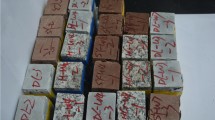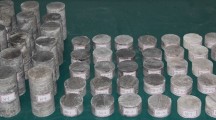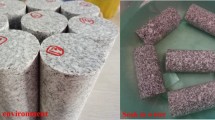Abstract
The effect of long-term water immersion on the mechanical properties of porphyritic gypsum rock containing coarse-grained gypsum minerals and a variety of fine-grained minerals was explored using uniaxial and triaxial compression tests. XRD, SEM, and EDS analyses were utilized to discuss the water-softening mechanism in relation to the rock fabric. The results show that the elastic modulus decreases while Poisson’s ratio increases for rocks without lateral confinement after long-term immersion, which exerts a weak effect on the internal friction angle of rocks but greatly weakens the cohesion. The softening effect of water on rocks attenuates nonlinearly with increasing immersion time, and the compressive strength changes as a logarithmic function of immersion time. As the confining pressure increases, the sensitivity of the compressive strength to immersion time tends to weaken. The increase in the confining pressure causes the transition from brittleness to ductility of rocks, and long-term water immersion leads to a decrease in the transitional confining pressure. The softening of rocks is attributed to structural damage caused by the dissolution of gypsum minerals and the disintegration of material zones composed of fine-grained minerals under immersion conditions. Water infiltration is facilitated by intergranular pores within the fine-grained mineral zone as microcracks are distributed along the gypsum cleavages and contact boundaries between coarse- and fine-grained mineral zones. During prolonged water immersion, the water activity shifts from a predominance of infiltration to that of dissolution and disintegration, resulting in a transient increase followed by a gradual decrease in the mass of gypsum rock.














Similar content being viewed by others
Data availability
All data generated or analyzed during this study are included in this published article.
References
Caselle C, Bonetto S, Costanzo D (2020) Crack coalescence and strain accommodation in gypsum rock. Frattura Ed Integrità Strutturale 52:247–255
Cooper AH (1998) Subsidence hazards caused by the dissolution of Permian gypsum in England: geology, investigation and remediation. Geol Soc London Eng Geol Spec Publ 15(1):265–275
Deere DU, Miller RP (1966) Engineering classification and index properties for intact rock. Technical report no. AFWL-TR-65-116, Air Force Weapons Laboratory, Kirtland Air Force Base, New Mexico, pp 308
Fan CF, Teng HH (2007) Surface behavior of gypsum during dissolution. Chem Geol 245(3):242–253
Gao MM, Zhu YB, Miao SS, Tian WH, Gong ZH, Ju ZT (2020) Experimental study on dissolution and strength characteristics of gypsum rock. Sci Technol Eng 20(8):2975–2980
Guinea A, Playà E, Rivero L, Himi M, Bosch R (2016) Geoelectrical classification of gypsum rocks. Surv Geophys 31:557–580
Hashemi M, Saki A, Nikudel MR (2020) Effects of chemical composition on the solubility and geomechanical characteristics of gypsum rocks from Gachsaran Formation. Iran Bull Eng Geol Environ 79:3785–3796
Holliday DW (1970) The petrology of secondary gypsum rocks: a review. J Sediment Res 40(2):734–744
ISRM (2007) The complete ISRM suggested methods for rock characterization, testing and monitoring: 1974–2006. In: Ulusay R, Hudson JA (eds) Compilation arranged by the ISRM Turkish National Group, Ankara, Turkey
Ma HF, Song YQ, Chen SJ, Yin DW, Zheng JJ, Chen FX, Li XS, Ma Q (2021) Experimental investigation on the mechanical behavior and damage evolution mechanism of water-immersed gypsum rock. Rock Mech Rock Eng 54:4929–4948
Mohammadian M, Lashkaripour GR, Moghaddas NH, Ghafoori M (2021) An investigation on karst development in gypsum and limestone (case study; Zagros folded zone, southwest of Iran). Carbonates Evaporites 45:1–13
Papadopoulos Z, Kolaiti E, Mourtzas N (1994) The effect of crystal size on geotechnical properties of Neogene gypsum in Crete. Q J Eng GeolHydrogeol 27(3):267–273
Piasta W (2017) Analysis of carbonate and sulphate attack on concrete structures. Eng Fail Anal 79:606–614
Rahimi MR, Mohammadi SD, Heidari M, Jalali SH (2020) Evaluation of the needle penetration test to estimate the uniaxial compressive strength of gypsum rocks. Arab J Geosci 14:1–15
Ramon A, Alonso EE (2018) Heave of a building induced by swelling of an anhydritic triassic claystone. Rock Mech Rock Eng 51:2881–2894
Ramon A, Caselle C, Bonetto SMR, Costanzo D, Alonso E (2021) Effect of microstructure and relative humidity on strength and creep of gypsum. Rock Mech Rock Eng 54:4121–4145
Ren S, Deng GL, Wu JX, Chen J (2017) Immersion tests on gypsum rocks using fresh water. Rock and Soil Mechanics 38(4):943–950
Ren S, Li Z, Deng G, Liu W, Pu W (2018) Softening characteristic of gypsum rock under the action of multi-factors. Rock Soil Mech 39(3):789–796
Tao M, Meng XX, Zhang DH, Hu YQ (2018) Using micro-computed tomography and scanning electron microscopy to assess the morphological evolution and fractal dimension of a salt-gypsum rock subjected to a coupled thermal-hydrological-chemical environment. Mar Pet Geol 98:316–334
Xia K, Chen C, Zhou Y, Liu X, Zheng Y, Pan Y (2019) Catastrophe instability mechanism of the pillar-roof system in gypsum mines due to the influence of relative humidity. Int J Geomech 19(4):1–16
Yilmaz I (2007) Differences in the geotechnical properties of two types of gypsum: alabastrine and porphyritic. Bull Eng Geol Environ 66:187–195
Yilmaz I (2010) Influence of water content on the strength and deformability of gypsum. Int J Rock Mech Min Sci 47(2):342–347
Yin XM, Zhang X, Lei YJ, Wang LN (2021) Response characteristics and mechanism of the strength and energy of schist to the schistosity orientation and water. Bull Eng Geol Environ 80:7029–7049
Yu WD, Liang WG, Li YR, Yu YM (2016) The meso-mechanism study of gypsum rock weakening in brine solutions. Bull Eng Geol Environ 75(1):359–367
Zhou YC, Chen CX, Liu XM, Duan SQ, Zhang HN, Xia KZ (2018) Experiments on ageing effect of gypsum rock induced by water. Rock Soil Mech 39(6):2124–2138
Zhu YB, Wu YL, Yu HM (2016) Experimental research on corrosion and leaching characteristics of gypsum rock surrounding tunnels. Modern Tunn Technol 53(1):28–37
Zhu C, Xu X, Liu W, Xiong F, Lin Y, Cao C, Liu X (2019) Softening damage analysis of gypsum rock with water immersion time based on laboratory experiment. IEEE Access 7:125575–125585
Funding
This research is financially supported by the Natural Science Foundation of China (Grant no. 52074112 and 41807240) and the Nature Science Foundation of Hubei Province (2023AFB607) and Hubei Key Laboratory of Disaster Prevention and Mitigation (China Three Gorges University) Open Fund (No.2022KJZ04) and Hubei Superior and Distinctive Discipline Group of “New Energy Vehicle and Smart Transportation.” The author gratefully acknowledges the financial support provided by them.
Author information
Authors and Affiliations
Corresponding author
Ethics declarations
Conflict of interest
The authors declare no competing interests.
Rights and permissions
About this article
Cite this article
Yin, X., Huang, Y., Lei, Y. et al. Response of the mechanical properties of impurity-bearing gypsum rocks with a porphyritic structure to long-term water immersion and softening mechanisms. Bull Eng Geol Environ 83, 148 (2024). https://doi.org/10.1007/s10064-024-03642-9
Received:
Accepted:
Published:
DOI: https://doi.org/10.1007/s10064-024-03642-9




